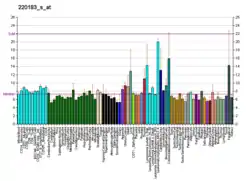NUDT6
Nucleoside diphosphate-linked moiety X motif 6 is a protein that in humans is encoded by the NUDT6 gene.[5][6][7]
| NUDT6 | |||||||||||||||||||||||||||||||||||||||||||||||||||
|---|---|---|---|---|---|---|---|---|---|---|---|---|---|---|---|---|---|---|---|---|---|---|---|---|---|---|---|---|---|---|---|---|---|---|---|---|---|---|---|---|---|---|---|---|---|---|---|---|---|---|---|
 | |||||||||||||||||||||||||||||||||||||||||||||||||||
| |||||||||||||||||||||||||||||||||||||||||||||||||||
| Identifiers | |||||||||||||||||||||||||||||||||||||||||||||||||||
| Aliases | NUDT6, ASFGF2, FGF-AS, FGF2AS, GFG-1, GFG1, nudix hydrolase 6 | ||||||||||||||||||||||||||||||||||||||||||||||||||
| External IDs | OMIM: 606261 MGI: 2387618 HomoloGene: 31425 GeneCards: NUDT6 | ||||||||||||||||||||||||||||||||||||||||||||||||||
| |||||||||||||||||||||||||||||||||||||||||||||||||||
| |||||||||||||||||||||||||||||||||||||||||||||||||||
| |||||||||||||||||||||||||||||||||||||||||||||||||||
| |||||||||||||||||||||||||||||||||||||||||||||||||||
| |||||||||||||||||||||||||||||||||||||||||||||||||||
| Wikidata | |||||||||||||||||||||||||||||||||||||||||||||||||||
| |||||||||||||||||||||||||||||||||||||||||||||||||||
FGF2 (MIM 134920) is a highly conserved, multifunctional heparin-binding growth factor involved in neuroectoderm development, angiogenesis, and wound healing.
Elevated levels of FGF2 are associated with proliferation of smooth muscle in atherosclerosis and with proliferation of tumors. The FGF2 antisense gene, NUDT6, may regulate FGF2 expression.[supplied by OMIM][7]
References
- GRCh38: Ensembl release 89: ENSG00000170917 - Ensembl, May 2017
- GRCm38: Ensembl release 89: ENSMUSG00000050174 - Ensembl, May 2017
- "Human PubMed Reference:". National Center for Biotechnology Information, U.S. National Library of Medicine.
- "Mouse PubMed Reference:". National Center for Biotechnology Information, U.S. National Library of Medicine.
- Murphy PR, Knee RS (Jan 1995). "Identification and characterization of an antisense RNA transcript (gfg) from the human basic fibroblast growth factor gene". Mol Endocrinol. 8 (7): 852–9. doi:10.1210/mend.8.7.7984147. PMID 7984147.
- Gagnon ML, Moy GK, Klagsbrun M (Apr 1999). "Characterization of the promoter for the human antisense fibroblast growth factor-2 gene; regulation by Ets in Jurkat T cells". J Cell Biochem. 72 (4): 492–506. doi:10.1002/(SICI)1097-4644(19990315)72:4<492::AID-JCB5>3.0.CO;2-H. PMID 10022609. S2CID 28384265.
- "Entrez Gene: NUDT6 nudix (nucleoside diphosphate linked moiety X)-type motif 6".
Further reading
- Knee RS, Pitcher SE, Murphy PR (1995). "Basic fibroblast growth factor sense (FGF) and antisense (gfg) RNA transcripts are expressed in unfertilized human oocytes and in differentiated adult tissues". Biochem. Biophys. Res. Commun. 205 (1): 577–83. doi:10.1006/bbrc.1994.2704. PMID 7999082.
- Li AW, Too CK, Knee R, et al. (1998). "FGF-2 antisense RNA encodes a nuclear protein with MutT-like antimutator activity". Mol. Cell. Endocrinol. 133 (2): 177–82. doi:10.1016/S0303-7207(97)00148-2. PMID 9406864. S2CID 43782586.
- Asa SL, Ramyar L, Murphy PR, et al. (2001). "The endogenous fibroblast growth factor-2 antisense gene product regulates pituitary cell growth and hormone production". Mol. Endocrinol. 15 (4): 589–99. doi:10.1210/me.15.4.589. PMID 11266510.
- Duplan SM, Théorêt Y, Kenigsberg RL (2002). "Antitumor activity of fibroblast growth factors (FGFs) for medulloblastoma may correlate with FGF receptor expression and tumor variant". Clin. Cancer Res. 8 (1): 246–57. PMID 11801566.
- Strausberg RL, Feingold EA, Grouse LH, et al. (2003). "Generation and initial analysis of more than 15,000 full-length human and mouse cDNA sequences". Proc. Natl. Acad. Sci. U.S.A. 99 (26): 16899–903. Bibcode:2002PNAS...9916899M. doi:10.1073/pnas.242603899. PMC 139241. PMID 12477932.
- Sheng Z, Lewis JA, Chirico WJ (2004). "Nuclear and nucleolar localization of 18-kDa fibroblast growth factor-2 is controlled by C-terminal signals". J. Biol. Chem. 279 (38): 40153–60. doi:10.1074/jbc.M400123200. PMID 15247275.
- Gerhard DS, Wagner L, Feingold EA, et al. (2004). "The status, quality, and expansion of the NIH full-length cDNA project: the Mammalian Gene Collection (MGC)". Genome Res. 14 (10B): 2121–7. doi:10.1101/gr.2596504. PMC 528928. PMID 15489334.
- Vasilescu J, Zweitzig DR, Denis NJ, et al. (2007). "The proteomic reactor facilitates the analysis of affinity-purified proteins by mass spectrometry: application for identifying ubiquitinated proteins in human cells". J. Proteome Res. 6 (1): 298–305. CiteSeerX 10.1.1.401.4220. doi:10.1021/pr060438j. PMID 17203973.
- Pezzatini S, Morbidelli L, Solito R, et al. (2007). "Nanostructured HA crystals up-regulate FGF-2 expression and activity in microvascular endothelium promoting angiogenesis". Bone. 41 (4): 523–34. doi:10.1016/j.bone.2007.06.016. PMID 17681892.
This article is issued from Wikipedia. The text is licensed under Creative Commons - Attribution - Sharealike. Additional terms may apply for the media files.




